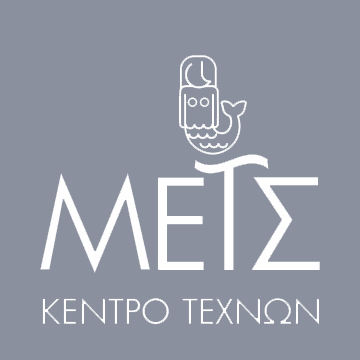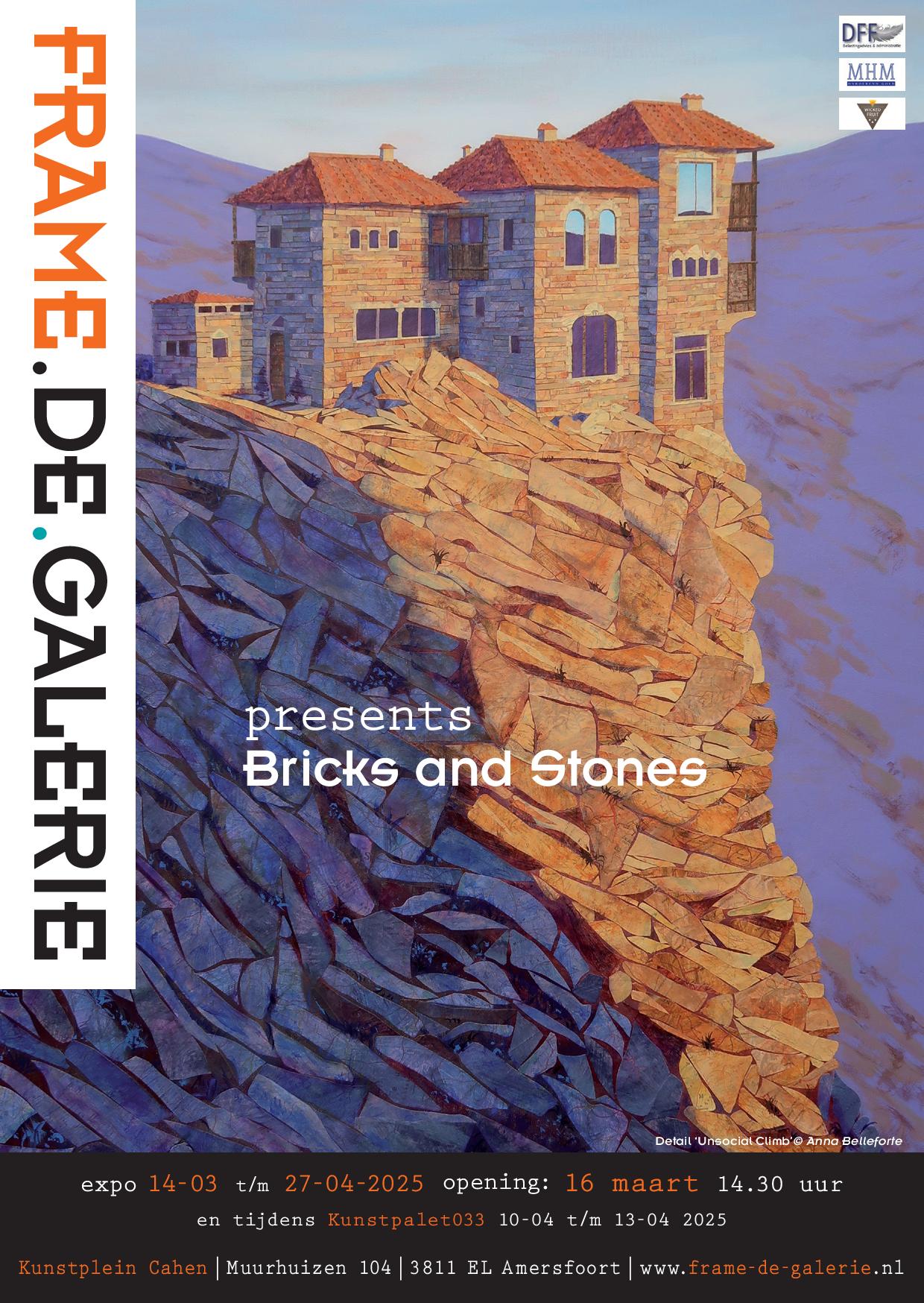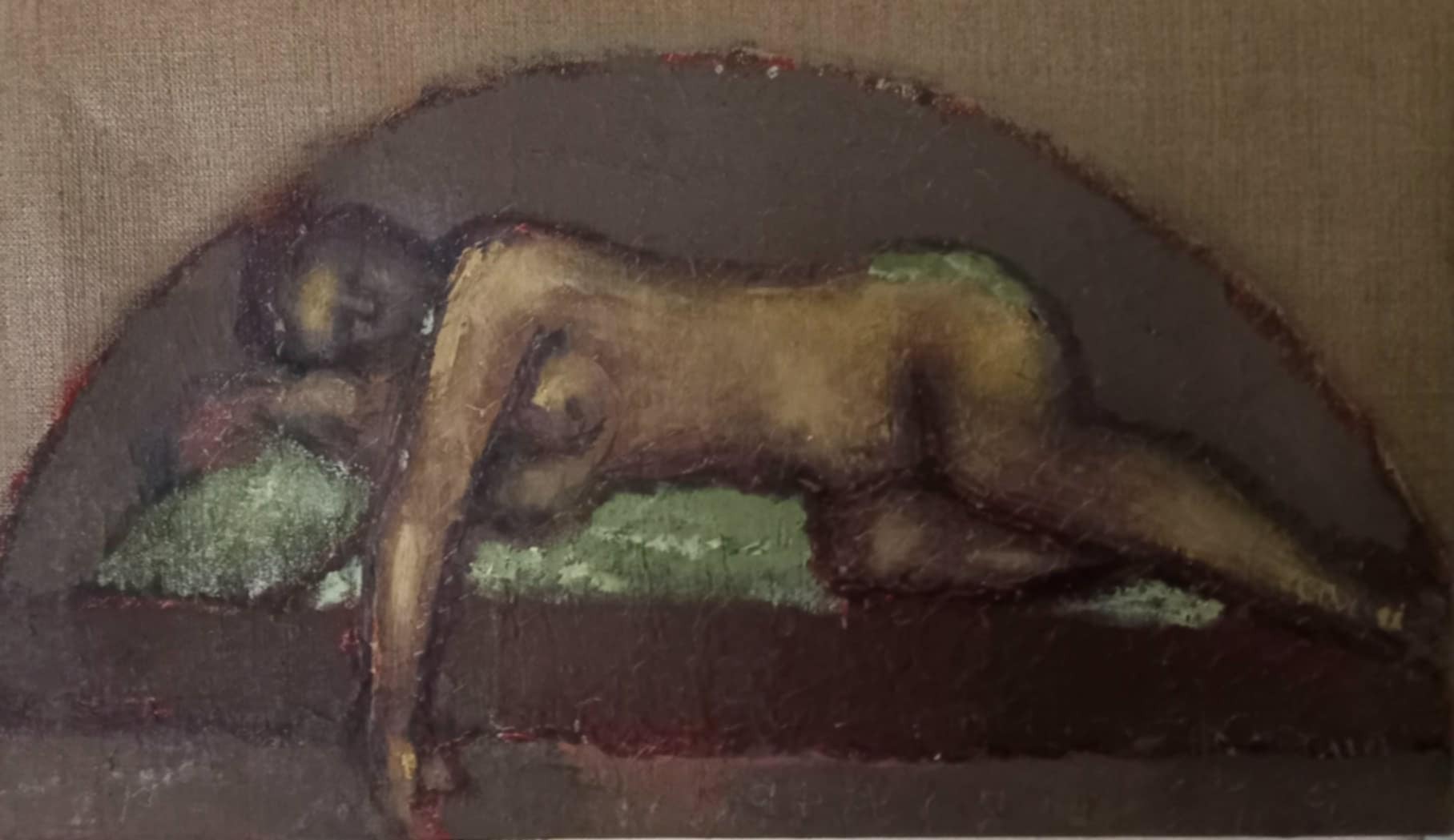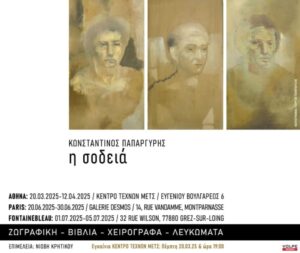“Bricks and Stones”: A Curatorial Exploration of Structure, Place, and Emotion
Το Κέντρο Τεχνών Μετς, σε συνεργασία με την Frame de Galerie στο Amersfoort της Ολλανδίας, παρουσιάζει την ομαδική έκθεση “Bricks and Stones”, με τη συμμετοχή συνεργαζόμενων εικαστικών του Κέντρου.
Η έκθεση εξερευνά τη σχέση ανάμεσα στο δομημένο και το φυσικό, την αντοχή της ύλης και τις μεταμορφώσεις του τοπίου, τόσο κυριολεκτικά όσο και συμβολικά. Μέσα από διαφορετικά μέσα και προσεγγίσεις, οι καλλιτέχνες αναστοχάζονται πάνω στην αρχιτεκτονική του χώρου, της μνήμης και της ανθρώπινης εμπειρίας.
Η έκθεση θα πραγματοποιηθεί σε δύο μέρη: το πρώτο θα φιλοξενηθεί στην Frame de Galerie από τις 16 Μαρτίου έως τις 28 Απριλίου, ενώ το δεύτερο θα συνεχιστεί στο Κέντρο Τεχνών Μετς από τις 24 Ιουλίου έως τις 20 Σεπτεμβρίου. Ένα εικαστικό ταξίδι που ενώνει καλλιτέχνες και θεατές σε έναν δημιουργικό διάλογο ανάμεσα σε δύο χώρες.
Η έκθεση Bricks and Stones διερευνά τη σχέση μεταξύ δομημένων μορφών και συναισθηματικών τοπίων, γεφυρώνοντας το υλικό με το άυλο. Τα τούβλα και οι πέτρες δεν είναι μόνο στοιχεία κατασκευής, αλλά και μεταφορές για τις εσωτερικές μας δομές, τα βάρη της μνήμης και τη διαδικασία της καλλιτεχνικής δημιουργίας.
Η έννοια του τόπου και των ριζών αποτελεί κεντρικό άξονα, φωτίζοντας την αρχιτεκτονική και πολιτιστική κληρονομιά που διαμορφώνει την ταυτότητά μας. Μέσα από διαφορετικές προσεγγίσεις, οι καλλιτέχνες εξερευνούν τη σύνδεσή τους με το παρελθόν και το πώς αυτή επηρεάζει την πρακτική τους.
Artists exchange
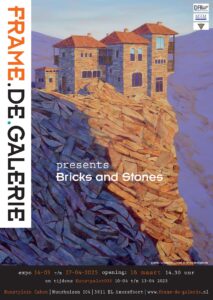
The exhibition Bricks and Stones
delves into the interplay between physical structures and emotional landscapes, bridging the tangible with the intangible. The theme draws inspiration from the fundamental elements of construction—bricks and stones—not only as materials that shape our environments but also as metaphors for the frameworks of our inner worlds. This dual lens invites us to consider our connection to place, self, and others, while exploring the emotional weights we carry—whether ancestral traumas, personal inhibitions, or even the iterative process of artistic creation.
The notion of place and roots emerges as a central thread in Bricks and Stones, drawing attention to the architectural and cultural heritage that shapes our collective and individual identities. The exhibition reflects on the structural essence of both ancient civilizations and contemporary experiences, examining how the enduring presence of architecture—whether as physical ruins or conceptual frameworks—speaks to ideas of permanence, memory, and belonging. Each artist engages with these themes uniquely, exploring their personal connection to the past, their relationship with their cultural heritage, and the ways these intersect with or diverge from their artistic practices. Through this dialogue, the exhibition raises questions about what unites or separates us from our roots and how these connections influence the creative process, ultimately shaping the structures we build within and around us.
In the context of this exhibition,
bricks and stones symbolize both beginnings and structures. They evoke the initial sketch of a composition, the foundation of a painting, and the birth of an artwork. Beyond the physical, they also serve as metaphors for the emotional shaping, evolution, and burdens carried by the human psyche. Like the bricks and stones that form the foundation of a building, these elements reflect the inner architecture of the self—our personal temple, embodied in the structure of our own bodies. Each work on display, created by five Greek artists, explores this theme through diverse techniques and mediums. Each artist brings their unique perspective, unraveling the connections between physical and emotional spaces, revealing the profound interplay between the tangible and the intangible, the seen and the felt.
The exhibition also serves as a platform for cultural and artistic exchange. Following its presentation in the Netherlands, it will host five Dutch artists in Greece, fostering a dialogue between two places and their artistic communities. This cross-cultural conversation enriches the thematic exploration, offering viewers layered interpretations and sparking their imagination.
By juxtaposing the universal with the personal and the structural with the ephemeral, Bricks and Stones invites audiences to reflect on the ties that bind us to ourselves, our places, and each other. It reminds us that, whether in art or life, the foundation matters—but so does what we build upon it.
Niovi Kritikou
Curator | Artist
Director of Mets Arts Center
Coordination: Anna Belleforte | Frame de Galerie
5 Dutch artists
Anna Belleforte
My work always explores architecture and the human scale. I look for stories through the lens
of what we build, have built, or wish to build. In telling these stories, the physical realities of
buildings – their texture, space, size – are as important as the emotional aspect of what
buildings mean to us, whether collectively or personally.
The current series, Unprecedented, features extreme domestic ambitions, from houses
of perfect isolation (but with all mod-cons) to the blissful ignorance of the consequences of
wanting more. They show situations unprecedented, unknown, unheard-of, yet so appealing:
desirable but improbable living, despite being built up with documentative maps which lend an
air of credibility.
The Palimpsest series of smaller works are more about architectural details. They are
more a record of human interventions in old buildings. The details of old facades can tell us
things about changing social or political circumstances, new fashions or old conflicts.
Bricks and stones are a constant in our lives, yet they are also the agents of change as
well as being evidence of change. That is a fascinating story.
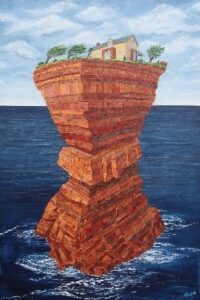
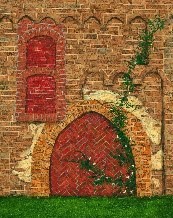
Hannah Blom
My work is built up in parts, which I often make myself. Just as a building is created by
composing bricks and stones into a unit, my works are created in a similar fashion. It is like
playing as I build fantasy worlds from different components: the result is sometimes familiar,
but it can just as often be something impossible. Perfection is not interesting. Welding marks
and joints often become part of the work. A new piece fascinates most when I don't (yet)
understand it myself, when it comes into being under my hands.
With iron, I weld delicate grass-like forms or tough abstract structures. I prefer old metal that is
being given a second life. The metal skins are left unembellished, keeping the rusty colour of
weathered material.
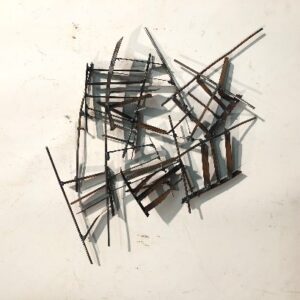
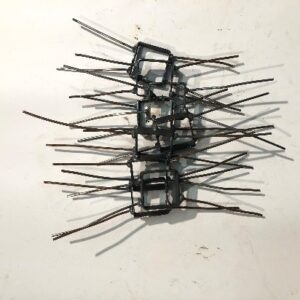
Marie-Louise Dooijes
We have always built things. Whether this was a temple in honour of something or a wall in defence of
the city. And eventually, structures fail to stand the test of time. Eventually they fall into ruin.
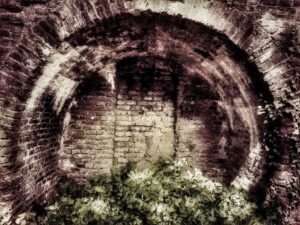
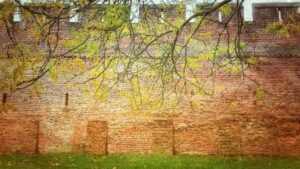
Sophia de Vries
“foundations”
My work is about monumentality. Not just in terms of the object itself, but also the space around it. I
create landscapes with a thin line of steel, I forge a row of trees, and there is a house in the distance.
You recognise it, you've seen it somewhere before. I use the shape of a house to define my landscape, it
makes the space visible, and makes the house a model of scale.
The foundations for my new work in this exhibition are the bricks of our old house, built in 1920. These
bricks emerged from a partition wall during the renovation. They served as the basis for investigating a
new material and for deepening my visual language. It's also about colour, the beautiful orange of
baked bricks versus the bluish skin of heated steel.
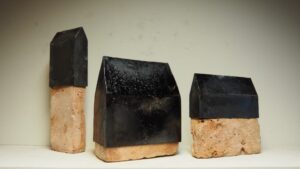
Mark van Praagh
“If the walls could talk”
I have long been fascinated by architecture, especially old walls, patterns in facades, rhythms in
windows and doors, and thus their history. How did the buildings come into being? What have these
old walls seen and experienced, what can they tell us? The ravages of time also leave many traces in
the walls, which are endlessly fascinating.
Living and working in Amsterdam, I am always fascinated by the variety of facades of the canal
and the interplay of shapes. You realise through the different styles that the city has a great history,
you suspect something of the status of the past and/or present owners and the development of the
city. The restoration of buildings also says something about the present.
In the series of oil paintings Amsterdam canals at night, I’ve tried to depict the quiet and
timeless atmosphere of all those different facades together. At night you see the glow of streetlights
and windows, plus their gleaming reflections on the rippling canals. Sometimes you get a glimpse of
something through the windows and get a feeling of the life within, and other times it’s dark inside and
nothing is revealed about who lives or works there. I also love the old houses in Amersfoort, for
example the Muurhuizen or Huis Tinnenburg. Here too, the patterns and colours of old bricks never
cease to fascinate.
In my watercolours I depict more of the (partly abstract) rhythms and earthy colours of old
facades and bricks. Each old bricks is different in shape and colour. My watercolour technique involves
glazing: building colour through transparent layers of paint. You can achieve all the rich earthy shades
found in bricks – they are fired clay, after all.
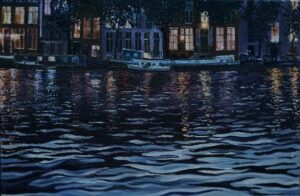
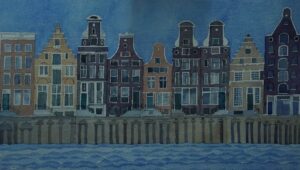
Greek artists
Athina Misegianni
The artistic practice I follow focuses on creating small paper sculptures. I use simple, everyday objects
to explore concepts such as loss and regeneration. These objects are transformed into fragile
fragments, which are displayed like ancient artifacts, creating new forms and redefining our initial
relationship and perception of them. Through these delicate forms, I invite the viewer to reflect on the
beauty of transience and the power of preserving the everyday.
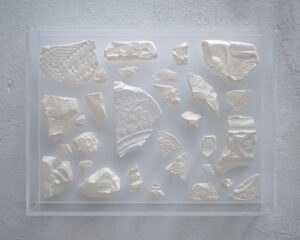
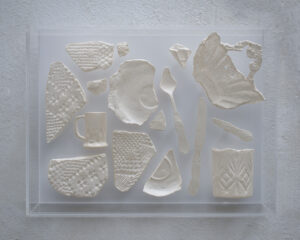
Panos Kampylis
I work figuratively in painting and drawing and I’m interested in finding new ways to render known
forms, and do so in both small and large formats. My technique evolves constantly as I experiment and
try to find the best way to visualize ideas. I focus on using gestural brush strokes with realistic and
expressionistic elements. I draws inspiration from real life situations, literature (including fantasy
books) or movies, trying to create a unique result.
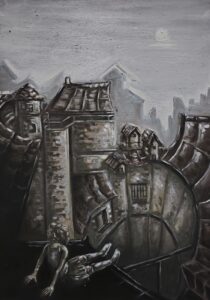
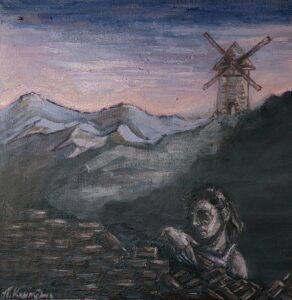
Emmeleia Filippopoulou
If an idea flashes like a spark and its power lingers, almost obsessively, that is when a work is realised.
My inspiration is mainly ignited by the serendipities of daily life revealed through keen and reverent
observation. I devoutly observe the environment, people, and animals, which often carry symbolic
resonance in my work. Having been shaped by the Peloponnesian landscape, I focus on the theatricality
that emerges both from its morphology and from the interplay of light and shadow. Additionally, my
work is nourished by elements from the language of music, such as the movement of melody, harmony
and rhythmic pulse. In a visual context, these could correspond to the movement of form, the colour
palette, and the repetition of patterns in rhythm. My practice embraces a variety of mediums, evolving
into installations of fragmented matter—fabric, wood, or rusted elements—sculptures, or even musical
performances. Yet, painting with oils or acrylics is a place to which I faithfully return. I find artistic
kinship in the visual traditions of Greek Art, Expressionism, and Arte Povera. Influences include Yannis
Tsarouchis, Marc Chagall, Francis Bacon, and Anselm Kiefer, whose artistic approaches strongly echo
within my own practice.
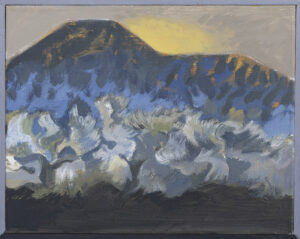
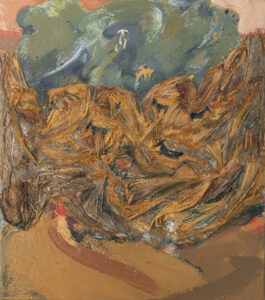
Fani Pantazidou
In my current work, I am interested in how our personal stories and the path of our lives relate to the
place we come from, our family environment. The column of pebbles in a liminal balance and the small
brick house symbolize the delicate balance within us, the experiences, the feelings we carry.
The pebbles, in their irregular form, drawn in black and white refer to the burdens and imprints of the
past. The small house, a stereotypical image functions as a symbol of our "home" and has a dual
interpretation, either as an emotional refuge or as the source of the problem. Even the title of the work
"Rosebud" has a reference to the film Citizen Kane, where it is a symbol of lost childhood and its
consequences in adulthood.
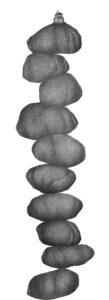
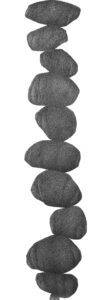
Dimitris Papadopoulos
My work consists of a series of studies, experimental drawings and paintings inspired by traditional
European art. I begin my research by having an abstract idea of philosophical, historical and religious
nature drawn from a vast collection of texts, and work my way towards refining my thoughts and
techniques for a sophisticated representation of my subject. My artistic endeavor is a continuous
search for what art can or should be once stripped of subjective fallacies and misconceptions. My desire
is to lead art to an objective and timeless field where beauty and truth are better understood by me or
like-minded students, artist and thinkers.
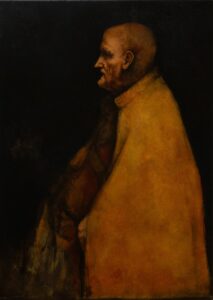
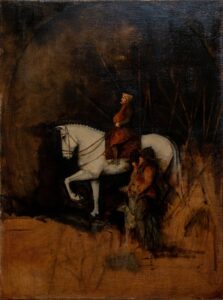
Danae Tsolaki (exhibiting in Athens)
